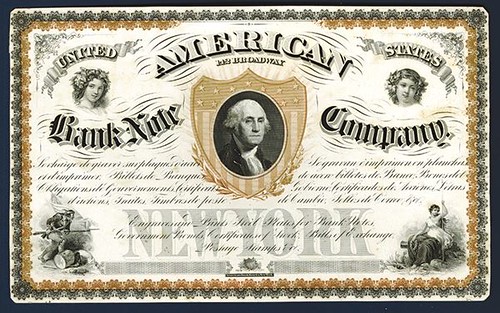
PREV ARTICLE
NEXT ARTICLE
FULL ISSUE
PREV FULL ISSUE
ON THE TYPES OF COIN EDGES

Pabitra Saha forwarded the above image of a new type of edge, found on the 10 Yuan bimetallic Year of the Sheep coin. He also helpfully provided a link to a nice discussion on coin edges in the Coin Community forum. Here are some excerpts.
-Editor
From "Sap", Brisbane, Australia Coinage issuers have long realised that placing an intricate, difficult-to-replicate pattern around the rim of a coin helps prevent the two scourges of trustworthy coinage: clipping and counterfeiting. I shall attempt to summarize the various edges you might find on coins. A plain edge has no marking of any kind on the edge, applied with a simple, flat collar die. In modern times, almost without exception, only base-metal coins had this kind of edge. Australian bronze coins and American cents and 5 cents have plain edges. A grooved edge is plain, but has a deep score or groove halfway across, all the way around the rim. The initial reaction of someone seeing such a coin for the first time is "it looks like two coins glued together". The 2 eurocent is an excellent example of this feature. A reeded edge has fine serrations like a file, all the way around the rim. Normally the reeding is vertical, but some early experiments had slanted reeding. Most modern silver and gold coins world-wide, and most of their cupronickel successors, have this kind of edge, also popularly known as a milled edge or filed edge. A security edge is a combination of grooved and reeded edge; often the furrow of the groove is decorated with a pattern (dots, lettering or some such) to make it even harder to duplicate. Hong Kong and India are traditional users of this kind of edge, though the high cost of applying it and the removal of precious metal from circulating coins have largely rendered this kind of edge obsolete. An inscribed edge has text around the rim. On older coins (like Maria Theresa thalers, US gold coins and British crowns), this text was placed on the collar die. Modern versions (like the USA Presidential Dollars) tend to use a second stage in the minting process to add the edge inscriptions. A decorated edge is similar to the inscribed edge, but patterns and symbols instead of letters are used. This term could be applied to the circles-and-rectangles pattern applied to Spanish "portrait" dollars, and to the recurring stars seen on many of the 2 euro coins. An interrupted reeded edge has alternating sections of reeded and plain edge. The 1 euro and Australian $1 circulating coins are classic examples of interrupted reeding. The Australian $2 also can be considered to have interrupted milling, though the spacing is different. An indented edge is a plain or milled edge with several indents or notches regularly spaced around it. This type of edge has recently come into fashion; the 20 eurocent and new New Zealand 20¢ coin have this kind of edge, also known as "Spanish flower". A herringbone edge is a specific kind of decorated edge, and resembles an early attempt at reeding; the pattern on the rim forms a series resembling interconnected arrows, or a "fish-bone" pattern. The Spanish "pillar dollar" of the early 1700's is a classic example of this kind of edge. A serrated edge is the term usually applied to ancient Greek and Roman coins with v-shaped notches painstakingly carved into the coin at regular intervals. Apparently a very crude attempt at applying something resembling a reeded or security edge. Polygons like the Australian dodecagonal 50¢ coins and British 20p and 50p coins, and scalloped coins like the Hong Kong $2 coin are normally considered to be different shapes, rather than having a "12-sided edge" or "scalloped edge". Such coins normally have plain edges; reeding or other patterns aren't easily applied to odd-shaped planchets. From "Metalman" of New Mexico Not one of my best pictures but I had a thread that I started sometime ago concerning coin edges ,, here are a few of what Sap described

To read the complete exchange, see:

Archives International Auctions, Part XXIII U.S. and Worldwide Banknotes, Security Printing Ephemera and U.S. Federal Bonds and Documents.
Highlights include:

1580 Lemoine Avenue, Suite #7 Fort Lee, NJ 07024 Phone: 201-944-4800 Email: info@archivesinternational.com WWW.ARCHIVESINTERNATIONAL.COM Wayne Homren, Editor The Numismatic Bibliomania Society is a non-profit organization promoting numismatic literature. See our web site at coinbooks.org. To submit items for publication in The E-Sylum, write to the Editor at this address: whomren@gmail.com To subscribe go to: https://my.binhost.com/lists/listinfo/esylum All Rights Reserved. NBS Home Page Contact the NBS webmaster 
|